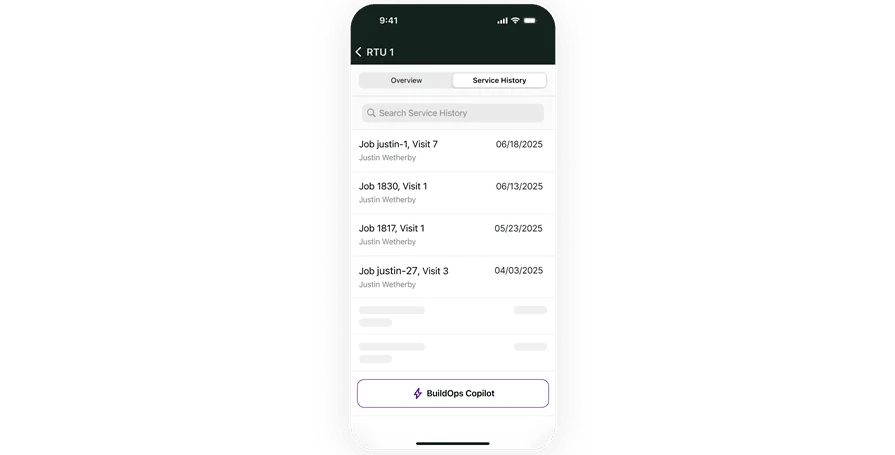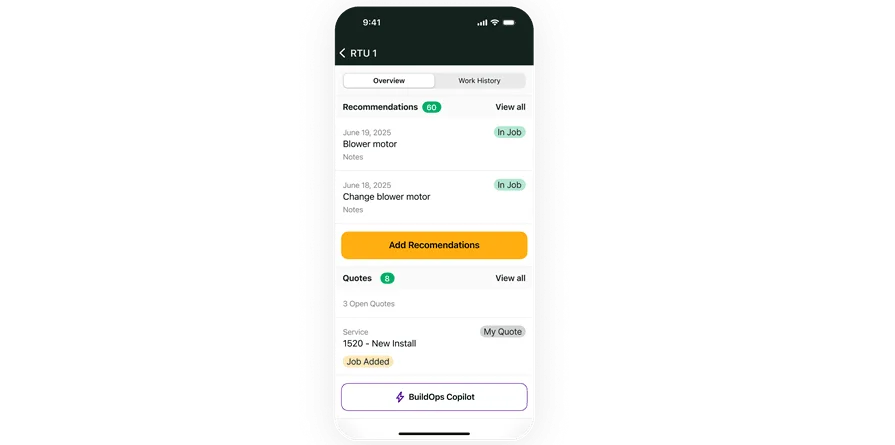Field technicians don’t get the luxury of a desk job. They’re troubleshooting HVAC systems in tight spaces, repairing electrical faults under pressure, or handling maintenance calls back-to-back. What they need isn’t another generic mobile tool. The best field service technician apps give them quick access to job details, real-time updates, and reliable functionality—no matter where the work takes them.
These tools are part of a bigger shift in how companies handle field service management. It’s not just about software—it’s about giving your team in the field what they need to do the job right, without delays or second guesses. Here’s what we’ll cover:
- How to choose the right field service technician app
- Key app features to get for your field service technicians
- 12 best field service technician apps that get the job done
- 7 benefits of using field service apps for technicians
- 4 important FAQs about field service technician app answered
Let’s break down how to choose a field service technician app that actually helps—not hinders—techs out in the field.
How to choose the right field service technician app
Plumbers, HVAC techs, electricians—they all know the job rarely happens in a perfect environment. You're on your back under a sink, sweating in a mechanical room, or juggling tools in a rooftop unit. Out there, every second counts. That’s why choosing from the best field service technician apps isn’t just a management decision—it’s a frontline priority.
The field service technician app you pick has to work the way your techs work. It should handle the rough conditions, deliver job-critical info fast, and keep everything moving without bottlenecks. If the app slows them down, it's not helping. Here's what to look for when making that call:
- On-the-job communication - Can techs reach dispatch or the office without dropping tools? Does the app support real-time status updates when something changes? Can it handle communication even when signal is weak or spotty?
- In-field job tracking and documentation - Can technicians log job notes, snap photos, and collect customer signatures directly in the app? Is the information stored automatically and linked to job history? Does the process take seconds—not minutes?
- Smart routing and location tools - Does the app offer GPS tracking that updates live? Can it reroute techs quickly during emergencies or traffic delays? Does it help reduce dead time between jobs?
- Built for tough conditions - Does the interface still work when gloves are on or screens are wet? Is everything readable under sunlight and simple to navigate under pressure? Does the app work offline and sync back once connected?
- Features - What critical tasks does the app cover—scheduling, dispatching, parts tracking, reporting? Are those features easy to use without training manuals? Were they clearly designed for field techs, not desk workers?
Selecting a field service technician app isn’t about ticking boxes. It’s about making sure your crew can get the job done without delay, confusion, or wasted motion. Next, we’ll look at the features that separate a good app from one your techs will actually use.
Key app features to get for your field service technicians
A field service technician app isn’t just a checklist tool—it’s a jobsite essential. Whether your tech is replacing a failed motor on a roof in July or checking refrigerant pressure in a cramped attic, they need fast, reliable tools that work without friction. The best field service technician apps do more than store job info—they support real-time decisions, reduce downtime, and make life easier in tough spots. Below are two categories of features designed specifically to help techs stay effective, even when the job throws a curveball.
Features for apps built for technicians on the job
Techs in the field need tools that keep pace with their day—no delays, no dead zones, no complicated menus. These features turn a smartphone into the technician’s best backup on the job:
- Real-time job updates - You’re halfway through a boiler inspection when dispatch pings you about an urgent call two blocks away. Can the app adjust your schedule, send job notes, and update your location without a phone call? Look for tools like the technician mobile app that help crews pivot fast.
- Mobile-first design - Working in gloves or dealing with sunlight glare? The interface should have large buttons, bold fonts, and layouts that are built for jobsite conditions—not boardrooms. If techs can’t use the app in the heat of the moment, they’ll skip it.
- Built-in documentation tools - After repairing a rooftop HVAC unit, a tech should be able to snap a photo, jot down notes, and capture a signature—all before climbing off the ladder. Apps like field service dispatch software often include photo logging and report capture built into the workflow.
- Offline access - Signal cuts out in basements, tunnels, and rural sites. The app should store job info locally, sync later, and never lock the tech out. If it only works with perfect reception, it’s not field-ready.
These tools aren’t about convenience—they’re about making sure the job gets done right the first time, no matter the setting.

Do more in the field
Field notes, upselling, reporting, instant quotes—your techs can do it all.
Features for apps focused on diagnostics and troubleshooting
Sometimes, the real work starts after a tech shows up. Equipment fails in ways manuals don’t cover. That’s where smart troubleshooting tools come in. These features help techs solve problems faster—especially when they’re flying solo:
- Interactive manuals and diagrams - Techs shouldn’t have to flip through PDFs or call the office when they’re in front of a unit they’ve never seen. An app should let them search model numbers and pull up specs, wiring diagrams, and pressure tables instantly.
- Sensor integration and real-time data - Imagine a tech testing airflow, and the numbers don’t add up. A good app lets them run diagnostics through connected sensors—catching problems like a weak motor or airflow imbalance before guesswork wastes time.
- Guided troubleshooting workflows - Newer techs get stuck on oddball issues. Apps with step-by-step guides offer a virtual mentor in their pocket—walking them through inspections, common fixes, and test procedures.
- Remote diagnostics - Before you even dispatch a tech, can your office team tap into a rooftop unit, check performance, and flag issues? This saves time and helps your tech show up with the right gear, avoiding trial-and-error repairs.
These features give field techs real backup—especially when they’re dealing with unfamiliar equipment or time-sensitive calls.
Features for apps that help with on-site calculations
When you're in the field, mistakes aren’t cheap. A miscalculated refrigerant load or wrong wire gauge can cause delays, callbacks, or worse—safety issues. That’s why strong calculation tools inside a field service technician app are essential. Here’s what to look for:
- Built-in field calculators - Need to size a breaker, calculate refrigerant charge, or determine pipe length? The best apps do the math for you. No switching to a separate tool. Everything—from HVAC loads to electrical current—is handled within the app in seconds.
- Quick access to industry formulas - Can your techs pull up voltage drop charts or wire sizing references without digging through code books? NEC standards and HVAC specs should be accessible with a few taps, cutting down on guesswork.
- Unit conversions on the fly - Working with European specs on a U.S. install? The app should convert pressure, power, and length units instantly. No delays, no misreads.
- Error prevention and alerts - A good app doesn’t just do the math—it double-checks it. If a tech enters a number that doesn’t add up (like 400 volts on a 120-volt panel), the app should throw a flag before the mistake makes it into the field.
These tools aren’t bells and whistles—they’re mission-critical when your techs are under pressure and every decimal point counts.
Features for apps that improve productivity and business management
Behind every tech in the field is a system that keeps the rest of the job moving—scheduling, parts tracking, invoicing, reporting. The best field service technician apps bring those tools together to cut the lag between jobsite and office. Look for apps that include:
- Real-time scheduling boards - A dispatcher sees a tech wrap up early—they reassign a nearby job with a drag-and-drop move. Tech gets an instant update, directions, and all job info. That’s what tools like field service scheduling software make possible.
- Fleet management visibility - A tech should never roll out to a job unsure if their van has the right tools or enough fuel. With fleet management software, dispatch can track vehicle status, location, and stock in real time.
- Performance and reporting tools How many callbacks did a job get? Who’s closing the most service calls on the first visit? Reporting tools give managers a real look at team performance—and techs visibility into how they’re doing without micromanagement.
- Seamless invoicing and payments - After finishing a job, a tech enters notes, and the system handles the rest. Invoicing, payments, and even CRM updates happen automatically—cutting down admin time and getting jobs closed faster.
- Service agreements and time tracking - Recurring jobs and contract work? Techs should be able to manage service agreements on the fly. Add time tracking to the mix, and everything from payroll to project costing becomes automatic.
These productivity-focused features keep field techs moving and office teams in sync. It’s not just about working faster—it’s about making sure the business runs clean from first call to final invoice.
12 best field service technician apps that get the job done
Field service technician apps aren’t one-size-fits-all. Plumbers need tools that can handle tight schedules, remote job sites, and fast-changing service calls—all while keeping office teams in sync. Some apps focus on mobile access to job data, while others support diagnostics, invoicing, or business operations.
Below, we break down 12 standout field service technician apps—starting with four designed specifically to support technicians while they’re on the job. These options help techs in the field pull up work orders, update job statuses, snap before-and-after photos, and keep moving without hitting tech snags.
Best field service apps for technicians on the job
Apps in this group focus on helping plumbers and field techs navigate daily service work—fast. From accessing job details to capturing signatures on-site, these apps are designed to keep the day running without constant check-ins or manual paperwork.
1. BuildOps
BuildOps is built specifically for commercial field service contractors, including plumbing, HVAC, fire safety, and electrical crews. For plumbers working across multiple properties or managing service contracts, it offers real-time asset tracking, AI-assisted notes, and job documentation tools—all in one place. The interface is clean, mobile-first, and built to handle jobsite conditions. Unlike other apps, BuildOps supports everything from routine maintenance to complex multi-day installs, making it ideal for plumbing teams that need accuracy without extra admin overhead.
Industry Specialization: Commercial service contractors
How Pricing Works: Per user, per month (annual contract)
What Sets It Apart: BuiltOps helps techs stay sharp with AI-powered documentation, real-time schedule updates, and asset details at their fingertips.
Key Features:
- Real-time job tracking: Live updates on scheduling changes and assignments, cutting back on call-ins
- Instant documentation: Techs can snap photos, collect signatures, and close jobs in seconds
- AI-assisted notes: Smart suggestions for faster, more complete job summaries

Want to see how the app works?
BuildOps keeps field crews & office teams aligned in real time.
2. Service Fusion
Image Source: Service Fusion
Service Fusion offers a mobile solution for both residential and light commercial field teams. Plumbers can update job notes, communicate with customers, and invoice directly from the app. GPS tracking also helps dispatchers monitor van locations in real-time. While it’s flexible, customization options are limited—especially for larger plumbing companies managing complex or high-volume service routes.
Industry Specialization: Residential and commercial field service
Pricing: Monthly plans based on features and team size
What Sets It Apart: GPS fleet tracking and two-way customer messaging keep communication smooth and routes efficient.
Key Features:
- Live GPS tracking: See tech location and reroute based on job urgency or traffic
- Mobile invoicing: Create and send invoices right from the app
- Two-way customer messaging: Text updates and reminders built into the workflow
3. FieldPulse
Image Source: FieldPulse
FieldPulse is a mobile-first app designed for small to midsize contractors who need easy access to scheduling, estimates, and customer job history on-site. Plumbers benefit from its in-app quoting tools and simple task checklists, which speed up service calls and reduce back-and-forth. However, the platform struggles with scalability, especially for companies that manage high work order volume or operate across several service zones.
Industry Specialization: Small to mid-sized field service contractors
Pricing: Custom quotes provided after demo
What Sets It Apart: Handy invoicing and quoting tools that help plumbers close jobs faster in the field.
Key Features:
- Job tracking and updates: View and edit jobs in real time
- Centralized customer records: See work history and open jobs with one tap
- Custom forms and checklists: Techs follow repeatable workflows to avoid errors
4. Jobber
Image Source: Jobber
Jobber is tailored for residential service pros, helping plumbers stay organized with mobile scheduling, on-the-spot payment collection, and job checklists. It’s clean and easy to use, making it a good pick for small teams with basic service workflows. That said, it may fall short for commercial contractors who need more control over asset tracking or complex service history.
Industry Specialization: Residential service contractors
Pricing: Tiered monthly pricing based on user count and features
What Sets It Apart: A client-facing portal that lets customers book services and pay online.
Key Features:
- Route optimization: Plan smarter routes to reduce downtime
- Invoicing and payments: Close jobs with fewer steps
- Standardized checklists: Ensure service quality stays consistent
Best field service apps for diagnostics and troubleshooting
Every field service tech runs into jobs where the problem isn’t obvious. Faulty components, system irregularities, and equipment you’ve never seen before—it’s part of the job. That’s where diagnostic-focused apps come in. These tools help technicians run tests, access manuals, and collect sensor data right from their phones, so they can make fast, informed decisions without second-guessing.
5. Bluon
Image Source: Bluon
Bluon provides technicians with access to a massive database of equipment manuals, refrigerant specs, pressure settings, and service tips. It's especially helpful when working with older or unfamiliar systems, thanks to its step-by-step troubleshooting support and live expert chat. While highly effective in HVAC environments, technicians in other trades may find limited functionality if their work doesn’t overlap with mechanical systems.
Industry Specialization: HVAC and mechanical service
Pricing: Free with additional features for registered users
What Sets It Apart: Thousands of searchable manuals and live support make it a powerful tool for in-the-field troubleshooting.
Key Features:
- Equipment manual access: Search models and view wiring diagrams, maintenance specs, and service history
- Refrigerant tools: Built-in calculators for retrofits and conversions
- Live tech support: Connect to real technicians for help diagnosing tough issues
6. Fluke Connect
Image Source: Fluke
Fluke Connect is built for techs who need data-driven insights on the job. It connects wirelessly to Fluke diagnostic tools—like meters, sensors, and thermal cameras—streaming live readings directly to a phone or tablet. It’s ideal for field teams who regularly handle electrical, HVAC, or mechanical systems that require accurate, real-time diagnostics. However, teams not using Fluke hardware may find the app’s features limited due to tool compatibility.
Industry Specialization: Electrical, mechanical, HVAC, and diagnostics
Pricing: Custom pricing available through Fluke
What Sets It Apart: Integrates seamlessly with Fluke’s hardware to deliver accurate diagnostic data in the field.
Key Features:
- Wireless tool sync: Pull diagnostics straight into the app from connected Fluke equipment
- Remote monitoring: View live data from off-site or share results with team leads
- Data history and reporting: Track system performance over time to spot recurring failures
Best FSM apps for making calculations on-site
Out in the field, accuracy isn’t optional. Whether it’s calculating load requirements, converting units, or estimating material needs, techs don’t always have time to double-check with the office. Apps in this category help field service technicians get the numbers right the first time—right from their mobile devices. No guesswork, no wasted materials, no callbacks due to math errors.
7. simPRO
Image Source: SimPRO
simPRO helps field service technicians generate accurate job estimates and perform on-site calculations for labor, materials, and parts. With built-in tools for cost estimation and measurement conversion, it allows techs to quickly quote jobs and track actual usage against estimates. This can be a major asset when dealing with project-based work or high-variation job sites. However, its complex interface may require a learning curve, especially for techs not used to deeper project workflows.
Industry Specialization: Commercial and residential service
Pricing: Subscription-based, contact for a custom quote
What Sets It Apart: Direct tie-in between estimates and calculations simplifies quoting on the job.
Key Features:
- Labor and materials calculators: Estimate time, quantity, and costs in real time
- Unit conversion: Instantly switch between imperial and metric for pressure, power, and length
- Integrated quoting: Convert calculations into service quotes with a few taps
8. ServiceWorks
Image Source: ServiceWorks
ServiceWorks delivers real-time calculation tools tailored to field service pros handling a mix of service and installation work. The app lets techs calculate job costs, equipment performance, and required materials directly from the field, making it easier to provide accurate updates and adjustments. While versatile, performance can slow down when managing large datasets or juggling multiple high-volume jobs.
Industry Specialization: General field service
Pricing: Tiered subscription based on team size and features
What Sets It Apart: Combines operational management with job-specific calculators that speed up field decisions.
Key Features:
- Job cost estimator: Quickly determine labor, parts, and total price
- Performance calculations: Analyze equipment metrics on-site
- Custom templates: Build repeatable calculators for recurring job types
Best field service apps for improving productivity and business management
Great field service work doesn’t stop at the job site—it depends on what happens before and after. From assigning jobs to collecting payments and tracking technician performance, these apps help keep everything running smoothly behind the scenes. They reduce delays, cut down admin work, and give teams the tools to stay organized no matter how busy the schedule gets.
9. Kickserv
Image Source: Kickserv
Kickserv makes it easy to manage customer information, schedule jobs, and handle billing—all from one place. With a mobile app that supports real-time job updates and technician tracking, it's a solid tool for keeping field and office teams in sync. However, its reporting customization is limited, which could be a drawback for contractors managing multi-site operations or tracking detailed performance data.
Industry Specialization: Residential and small commercial
Pricing: Basic plans start at $19/month
What Sets It Apart: Combines core service features into one lightweight app that’s easy to use for busy field techs.
Key Features:
- Live job tracking and technician status
- Automated invoicing and CRM updates
- Team performance and task history reporting
10. FieldRoutes
Image Source: FieldRoutes
FieldRoutes is known for its strong automation engine, handling everything from smart routing and dispatching to follow-up emails and payments. It’s a go-to for businesses that need to keep techs moving while minimizing manual tasks. The app performs best for growing teams, though some users report challenges with equipment data tracking in large-scale commercial operations.
Industry Specialization: General field service
Pricing: Custom pricing based on business size
What Sets It Apart: Smart scheduling engine that adjusts jobs in real time based on technician location and job urgency.
Key Features:
- Dynamic routing and smart job assignments
- Automated customer updates and communication
- Field reporting for technician and revenue performance
11. ServiceTitan
Image Source: ServiceTitan
ServiceTitan is a powerful option for teams that need deep reporting, job costing, and performance management. It’s particularly effective for mid-sized and enterprise contractors looking to scale with full visibility into every job. While packed with features, the platform can feel heavy for smaller companies and may require training to get the most out of its tools.
Industry Specialization: Residential and commercial contractors
Pricing: Quote-based for medium to large teams
What Sets It Apart: Combines business analytics, CRM, and technician tracking into a scalable platform.
Key Features:
- In-depth reporting and dashboards
- Job costing and performance insights
- Integrated CRM and workflow management
12. Housecall Pro
Image Source: Housecall Pro
Housecall Pro simplifies scheduling, dispatching, and payments in a clean, mobile-friendly interface. It’s designed for residential service teams that want to cut down admin time and keep jobs moving from quote to payment. While efficient for day-to-day service workflows, larger teams may find it lacks the depth needed for handling complex service contracts or detailed analytics.
Industry Specialization: Residential service contractors
Pricing: Tiered monthly plans
What Sets It Apart: Intuitive job tracking and client-facing tools that keep homeowners engaged and informed.
Key Features:
- Online booking and dispatch board
- One-tap invoicing and payment collection
- Post-job follow-ups and customer reviews

Get the software scoresheet
Compare top tools at a glance with this easy-to-use scoresheet.
7 benefits of using field service apps for technicians
Field service technician apps don’t just simplify tasks—they eliminate bottlenecks. From faster updates to fewer manual processes, the right app gives technicians everything they need while on the job. Whether it’s reducing wasted trips or improving job accuracy, these benefits directly impact the quality and speed of work techs can deliver in the field.
1. Real-time job visibility reduces errors and delays
Field technicians often deal with changes on the fly—whether it’s a different job scope, updated location, or new customer notes. A field service technician app keeps them updated in real time, helping avoid costly mistakes or miscommunication. It keeps everyone aligned without the need to check back with dispatch. This kind of visibility is a key part of modern field service management solutions that prioritize accurate, real-time coordination between the office and field.
2. Stronger communication with dispatch and office teams
No more calling the office mid-job or relying on outdated whiteboards. With in-app messaging and status updates, techs can communicate quickly and clearly—reducing response times and confusion. It ensures everyone from the dispatcher to the billing team is in the loop, which is especially useful when tools like field service dashboards are used to monitor job statuses in one view.
3. Faster invoicing speeds up cash flow
Techs can send completed job details to billing without delay. With photos, material logs, and digital signatures already in the app, invoicing can happen as soon as the job is done. This eliminates the lag between service and payment, giving businesses faster turnaround on billing cycles. A well-integrated field service invoicing software streamlines this process by syncing directly with accounting systems.
4. Fewer inventory errors and wasted trips
Bringing the wrong parts to a job—or realizing something’s missing—kills momentum. Apps that show van stock or warehouse availability let techs double-check what they have before heading out. This kind of visibility helps avoid return trips and keeps jobs on schedule.
Expert Tip
This is especially effective when paired with field service asset management tools that track equipment usage and inventory in real time.
5. Cleaner documentation protects against job disputes
Sloppy paperwork or missed details can lead to callbacks and customer complaints. A solid app allows techs to upload photos, log notes, and complete job reports while still on-site—before details are forgotten. This helps companies protect against billing issues or warranty claims later. Many rely on field service reporting tools to ensure all job information is organized, timestamped, and easy to access later.
6. Smarter scheduling helps dispatchers react faster
When a tech finishes early or a new job comes in, dispatch needs to reassign fast. Field service apps give dispatchers a live view of every technician’s status, helping them assign jobs based on location, availability, or skill. It’s a huge upgrade from static spreadsheets or manual check-ins. This level of flexibility is core to any responsive field service scheduling system designed to manage a busy, shifting workload.
7. Higher job satisfaction and lower burnout
When techs spend less time chasing paperwork or calling dispatch for updates, they can focus on doing actual work. Field service technician apps reduce frustration, help avoid double-bookings, and give techs control over their day. This leads to fewer missed details, better customer service, and more engaged teams. Tracking the right field service metrics and KPIs can even highlight where these apps improve technician performance and morale across the board.
4 important FAQs about field service technician app answered
A solid field service technician app can completely change how techs handle daily work—but there are still plenty of questions. What exactly do these apps do? Who benefits most from them? And how do you actually use them effectively out in the field? Below, we’ve answered the four most common questions field techs ask about using these apps—so you can hit the ground running with the info that matters.
1. What is a field service technician app?
A field service technician app is a mobile tool that gives access to job details, work updates, digital forms, and office communication—all while they’re out on calls or in the field. These apps are built to support field teams by cutting out manual paperwork and delivering real-time updates.
Whether it’s checking job status, uploading photos, or adjusting schedules, techs can handle it from the app—no laptop or office visit required. By keeping job info accurate and accessible in one place, these tools help techs stay on track and deliver better results with fewer interruptions.
2. How do field service technician apps work?
These apps act as the connection between field teams and the office. Job assignments, customer info, parts availability, and real-time changes all flow through a centralized mobile platform. Instead of waiting on a call or digging through emails, techs see what they need right in the app.
When a job is finished, the status updates instantly—triggering reports, invoicing, or even follow-up scheduling. Everything syncs behind the scenes, so the office always knows what’s happening, and the tech can move on to the next task without delay.
3. Who should be using a field service technician app?
If you’re a technician in the field—regardless of trade—you’ll benefit from an app that helps manage day-to-day chaos. Whether you’re fixing AC units, repairing electrical systems, servicing plumbing calls, or handling fire protection, the right app keeps you one step ahead. No bouncing between paperwork, text threads, and phone calls.
These apps are built for techs on the move. They streamline communication, reduce confusion, and help every job go smoother—from first dispatch to final signature.
4. What are the best practices for using field service technician apps?
Having the right app is only half the battle—how you use it determines how much value you actually get. Field service techs who consistently follow best practices can move faster, communicate clearly, and close jobs with fewer issues. Here are 10 proven habits to help you get the most out of any field service technician app:
- Always update job statuses in real time
- Review job details before arriving on site
- Upload job photos before leaving the property
- Collect customer signatures immediately after completing work
- Log notes while the work is still fresh
- Double-check parts or tools using inventory features
- Use built-in routing tools to plan your day efficiently
- Communicate changes or issues through the app—not by phone
- Sync reports or forms before moving on to the next job
- Keep the app open and active during your shift for live updates
The job of a field service technician isn’t getting easier—tighter deadlines, more complex systems, and higher customer expectations are now the norm. That’s why the tools techs rely on in the field matter more than ever. A well-chosen field service technician app can mean the difference between barely keeping up and consistently getting ahead.
From reducing paperwork and miscommunication to improving response times and job documentation, these apps are changing how work gets done out there. And while there’s no shortage of options, the best apps are the ones that meet techs where they are—in the middle of the job, tools in hand, and no time to waste.
For commercial teams juggling multiple jobs, assets, and service contracts, using an all-in-one platform can make a huge difference. That’s where BuildOps comes in—designed specifically for commercial field service contractors, helping technicians manage everything in one streamlined place.

Take a closer look at BuildOps
We help field techs keep pace with the job and stay in touch with the office.








